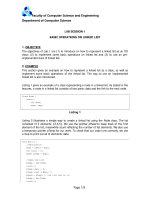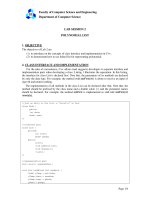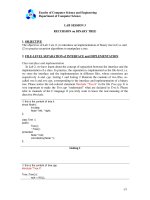Faculty of Computer Science and Engineering Department of Computer Science LAB SESSION 1 pptx
Bạn đang xem bản rút gọn của tài liệu. Xem và tải ngay bản đầy đủ của tài liệu tại đây (98 KB, 5 trang )
Faculty of Computer Science and Engineering
Department of Computer Science
Page 1/5
LAB SESSION 1
BASIC OPERATIONS ON LINKED LIST
1. OBJECTIVE
The objectives of Lab 1 are (1) to introduce on how to represent a linked list as an OO
class; (2) to implement some basic operations on linked list and (3) to use an pre-
implemented class of linked list;
2. EXAMPLE
This section gives an example on how to represent a linked list as a class, as well as
implement some basic operations of the linked list. The way to use an implemented
linked list is also introduced.
Listing 1 gives an example of a class representing a node in a linked list. As stated in the
lectures, a node in a linked list consists of two parts: data and the link to the next node.
class Node {
public:
int data;
Node* next;
}
Listing 1
Listing 2 illustrates a simple way to create a linked list using the Node class. The list
consisted of 3 elements: {2,3,5}. We use the pointer pHead to keep track of the first
element of the list, meanwhile count reflecting the number of list elements. We also use
a temporary pointer pTemp for our work. To check that our code runs correctly, we use
a loop to print out all of elements’ data.
void main() {
//declaration
Node * pHead = NULL;
int count = 0;
Node* pTemp = NULL;
//make the list
pTemp = new Node;
count++;
pTemp->data = 5;
pTemp->next = NULL; //
pHead = pTemp; // the list now is {5}
pTemp = new Node;
count++;
Faculty of Computer Science and Engineering
Department of Computer Science
Page 2/5
pTemp->data = 3;
pTemp->next = pHead;
pHead = pTemp; // the list now is {2,3}
pTemp = new Node;
count++;
pTemp->data = 2;
pTemp->next = pHead;
pHead = pTemp; // the list now is {2,3,5}
//print them out
while (pTemp!=NULL) {
cout << pTemp->data;
pTemp = pTemp->next;
}
}
Listing 2
In that way, our program looks ill-organized. In Listing 3, we then improve it by
combining pHead, count into a class named List. Then the operation of inserting a new
element into the list will be implemented as the method addFirst. We also implement
method display to print out the list elements. Note that we use constructor to initialize
the head of the list as NULL, and destructor to free the memory allocated.
class List{
private:
int count;
Node* pHead;
public:
List() {pHead=NULL; count = 0;}
void addFirst(int newdata) {
Node* pTemp = new Node;
pTemp->data = newdata;
pTemp->next = pHead;
pHead = pTemp;
count++;
}
void display() {
Node* pTemp = pHead;
while (pTemp!=NULL) {
cout << pTemp->data;
pTemp = pTemp->next;
}
}
~List() {
Node* pTemp = pHead;
while (pTemp!=NULL) {
pTemp = pTemp->next;
delete pHead;
pHead = pTemp;
Faculty of Computer Science and Engineering
Department of Computer Science
Page 3/5
}
}
}
Listing 3
Having the List class implemented, the main function can be rewritten far simpler as
depicted in Listing 4.
void main(){
List aList;
aList.addFirst(5);
aList.addFirst(3);
aList.addFirst(2);
aList.display();
}
Listing 4
The implementation of a class for linked list as above-described in this section is just an
example. There are many other variations of implementations for linked list as discussed
in the Appendix section. Students can choose what they feel appropriate when working
with exercises and assignments.
3. EXERCISES
Required exercises:
3.1. Rewrite the main function in Listing 4 to build and display a linked list as
follows
{12, 6, 29, 12, 51, 35, 83, 35, 78}.
3.2. Consider the following function
List* buildPosLinkedList()
{
List pList = new List;
int valid=1;
char choice;
int num;
while (valid) {
cout << “Do you want to enter a number? (Y/N):”;
cin >> choice;
if ((choice == ‘Y’) || (choice == ‘y’)) {
cin >> num;
if (num>0) pList.addFirst(num);
} else valid = 0;
}
Faculty of Computer Science and Engineering
Department of Computer Science
Page 4/5
return pList;
}
a. Rewrite the main function in Exercise 3.1 to do the following tasks:
- use the buildPosLinkedList function to create a list of positive numbers
based on input from user.
- display the list
- free the memory allocated to the list
b. Modify buildPosLinkedList into buildEvenLinkedList to create a list of even
numbers (the numbers can be positive or negative).
3.3. Write for the class List in Listing 3 an additional method int
addFirstIfPerfectSquare (int n) which adds n to the list if n is a square
number. In that case the returned result is 1, otherwise 0.
3.4. Write for the class List in Listing 3 an additional method void addLast(int
n) which adds n to the last position of the list.
3.5. Write for the class List in Listing 3 an additional method void
addEvenFirst(int n) which
adds n to the first position of the list if n is an even number (n mod 2 ==
0),
adds n to the last position of the list if n is an odd number (n mod 2 !=
0).
3.6. Write for the class List in Listing 3 an additional method int addPost(int n,
int index) which adds n to the i
th
position of the list. The index of the first
position in the list is 1. Assume that the list is having more than i elements
when called.
Advanced exercises:
3.7. Write for the class List in Listing 3 an additional method int
addIfOrdered(int n) which adds n to the list if it has been sorted and there is
no element which has value n. n is added to the list so that the ordering of
the list is maintained (a list containing 1 element or an empty list is
considered as an ascending ordered list). This method will return:
Faculty of Computer Science and Engineering
Department of Computer Science
Page 5/5
0 if the list is unsorted.
1 if the list is sorted in ascending order but there existed one element
which has value n.
2 if the list is sorted in ascending order and n is added successfully.
3 if the list is sorted in descending order but there existed one element
which has value n.
4 if the list is sorted in descending order and n is added successfully.
3.8. Write for the class List in Listing 3 an additional method void reverseList()
that reverses the elements in List. Your solution should contain only 1 loop.
3.9. Write for the class List in Listing 3 an additional method int
countIncreLists() which counts the number of the ascending ordered sublists
in the list. For example, when called with the list as built in Exercise 3.1, we
have 4 ascending ordered sublists {12}, {12, 79, 82}, {21, 43}, {31, 35, 57}.
Therefore, the returned result is 4.
3.10. Write for the class List in Listing 3 an additional method void
removeMidElement() that removes the middle element of the list. If the list
has 2n elements, remove the n
th
position of the list, otherwise if the list has
(2n + 1) elements, remove the (n+1)
th
position of the list. Your solution
should fulfill the following requirements:
Only 1 loop allowed
Do NOT use the count field
Do NOT call other supplementary methods of the class List
It is NOT a recursive algorithm.
3.11. Assuming that we have two ordered list a and b that are arranged in
ascending order. Write for the class List in Listing 3 an additional method void
concatenateOrderedList(List a, List b) that concatenates these lists to create a
new ordered list. After executing this method, a will point to this new list and
b will point to NULL.
End









